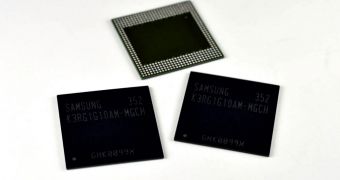Following the launch of Galaxy Note 3 with 3GB of RAM inside, South Korean mobile phone maker Samsung is getting ready for the inclusion of more memory inside future devices, as it has just announced a 4GB mobile RAM module.
This is the first 8-gigabit (Gb), low-power double data rate 4 (LPDDR4), mobile DRAM in the world, and it should open the door for more powerful smartphones and other mobile devices for the next year and beyond.
The new module is expected to offer “the highest level of density, performance and energy efficiency for mobile memory applications,” a recent post on Samsung Tomorrow explains.
Thus, users will enjoy faster and more responsive applications on their devices, as well as more advanced features. The new mobile RAM module also promises support for higher resolution displays, as well as better battery life.
“This next-generation LPDDR4 DRAM will contribute significantly to faster growth of the global mobile DRAM market, which will soon comprise the largest share of the entire DRAM market,” said Young-Hyun Jun, executive vice president, memory sales & marketing, Samsung Electronics.
“We will continue introducing the most advanced mobile DRAM one step ahead of the rest of the industry so that global OEMs can launch innovative mobile devices with exceptional user convenience in the timeliest manner.”
The new 8Gb LPDDR4 DRAM has been fabricated using the 20-nanometer (nm) class process technology, which offers 1 gigabyte (GB) on a single die, Samsung explains. This means that it has the largest density available for DRAM components today.
Moreover, the new RAM makes use of Low Voltage Swing Terminated Logic (LVSTL) I/O interface, which can offer a data transfer rate per pin of 3,200 megabits per second (Mbps), two times more than 20nm-class LPDDR3 DRAM now in mass production.
According to Samsung, the new LPDDR4 interface should deliver 50 percent better performance levels compared to the fastest LPDDR3 or DDR3 memory, while requiring around 40 percent less energy at 1.1 volts.
The new module is aimed at the premium mobile market, such as UHD smartphones with large screens, as well as tablets and ultra-slim notebooks, promising four times the resolution of full-HD devices.

 14 DAY TRIAL //
14 DAY TRIAL //